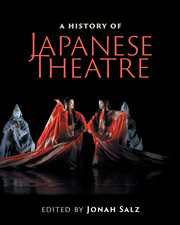Book contents
- Frontmatter
- Contents
- List of figures
- List of tables
- Contributors
- Contributors’ biographies
- Foreword
- Acknowledgments
- Note on Japanese terms
- List of abbreviations
- Timeline
- Editor's introduction
- I Traditional theatres
- Preface to Part I Japanese civilization arises
- 1 Ancient and early medieval performing arts
- Interlude Katari narrative traditions: from storytelling to theatre
- 2 Noh and Muromachi culture
- Interlude Noh and kyogen costumes and masks
- 3 Kyogen: classical comedy
- Interlude Iemoto : the family head system
- 4 Kabuki: superheroes and femmes fatales
- Interlude Nihonbuyo: classical dance
- Interlude Okinawan theatre: boundary of Japanese theatre
- 5 Bunraku: puppet theatre
- Interlude Misemono and rakugo : sideshows and storytelling
- Interlude Kamigata geinō : Kyoto-Osaka style
- Interlude Traditional theatre tomorrow: interview with Takemoto Mikio
- II Modern theatres
- Preface to Part II
- III Arcs and patterns
- IV Theatre architecture
- Preface to Part IV Evolution of Japanese theatre architecture
- V Theatre criticism
- VI Intercultural influences
- Epilogue: Frozen words and mythology
- Further reading
- Index
- References
5 - Bunraku: puppet theatre
from Preface to Part I Japanese civilization arises
Published online by Cambridge University Press: 05 July 2016
- Frontmatter
- Contents
- List of figures
- List of tables
- Contributors
- Contributors’ biographies
- Foreword
- Acknowledgments
- Note on Japanese terms
- List of abbreviations
- Timeline
- Editor's introduction
- I Traditional theatres
- Preface to Part I Japanese civilization arises
- 1 Ancient and early medieval performing arts
- Interlude Katari narrative traditions: from storytelling to theatre
- 2 Noh and Muromachi culture
- Interlude Noh and kyogen costumes and masks
- 3 Kyogen: classical comedy
- Interlude Iemoto : the family head system
- 4 Kabuki: superheroes and femmes fatales
- Interlude Nihonbuyo: classical dance
- Interlude Okinawan theatre: boundary of Japanese theatre
- 5 Bunraku: puppet theatre
- Interlude Misemono and rakugo : sideshows and storytelling
- Interlude Kamigata geinō : Kyoto-Osaka style
- Interlude Traditional theatre tomorrow: interview with Takemoto Mikio
- II Modern theatres
- Preface to Part II
- III Arcs and patterns
- IV Theatre architecture
- Preface to Part IV Evolution of Japanese theatre architecture
- V Theatre criticism
- VI Intercultural influences
- Epilogue: Frozen words and mythology
- Further reading
- Index
- References
Summary
Traditional three-man puppet-theatre bunraku (文楽) should properly be called jōruri ayatsuri (浄瑠璃操り) or ningyō jōruri (人形浄瑠璃). These terms stress the two major elements of the art: performed to the accompaniment of recited narrative music (jōruri) known as gidayū bushi, it involves the manipulation (ayatsuri) of puppets (ningyō). Texts of high literary quality and psychological nuance are expressed through delicate-featured puppets, intricately controlled by three-person teams. It provided urban audiences in Tokugawa Japan (1603–1868) with a serious, ethically and emotionally complex theatre form that has survived to the present day.
ELEMENTS OF PERFORMANCE
By Alan Cummings
Bunraku is a composite performance art in which stories are narrated to musical accompaniment while being enacted by puppets. The combination of the realistic, delicate movement of the large puppets with the intensely dynamic, virtuosic narration and shamisen playing creates a uniquely emotionally affective form of theatre.
Performance conventions
Puppets for major roles are large, between a half and two-thirds life-size, manipulated by three puppeteers moving in unison. The lead puppeteer (omozukai) is dressed formally with his face visible, while two hooded assistants are dressed in black. Puppets consist of a frame, head, hands, and feet, the last for male roles only – female feet are covered by kimono. Puppets are elaborately constructed, with movable eyes, eyebrows, mouths, wrists, and fingers, controlled by a hand-held toggle. Simpler, one-man puppets are used for minor roles and animals. Heads are categorized according to age, sex, marital status, class, and type of character, with seventy distinct heads in general use. Puppeteers dress their own puppets, padding the frame with cotton wadding to create the sense of the character's body before adding a wig and sewing the costume to the frame.
The movement of the puppets is fluid and remarkably lifelike, with puppeteers learning several dozen movement patterns (furi) to suggest everyday actions like sitting, running, and smoking, as well as more abstract patterns (kata) demonstrating intense emotion or to display a puppet's costume.
The chanter (tayū) provides narration as well as all dialogue. He must suggest the characters’ mental state and emotions, as well as their words and actions. Voice projection is powerful and delivered from the diaphragm, supported by a cloth belly-band and a heavy sandbag placed in the kimono.
- Type
- Chapter
- Information
- A History of Japanese Theatre , pp. 155 - 183Publisher: Cambridge University PressPrint publication year: 2016



